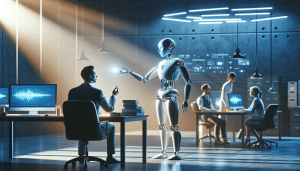AI Tools You Can Use Every Day
Aiden Foster September 13, 2025
Artificial intelligence is everywhere, shaping how people work, learn, and interact. This guide explores real-world AI tools designed to streamline daily tasks, boost productivity, and inspire creativity—all without complicated jargon or overpromises.
Making Life Simpler with AI Assistants
AI-powered digital assistants are quickly becoming integral to modern living. These intelligent helpers, such as virtual scheduling bots and voice-activated devices, manage calendars, reminders, and even control smart home gadgets. With natural language processing, daily communication becomes smoother and more effective. Many people discover that complex errands, like scheduling appointments or sending follow-up emails, can be completed with quick voice or text commands. It feels effortless, reducing mental burden and freeing up time for creativity. For those concerned with privacy and data use, reputable providers publish robust safety guidelines to help users feel comfortable adopting these tools (see Consumer Reports).
Beyond convenience, AI assistants adapt to individual needs over time. By learning preferences, these tools make increasingly relevant recommendations and anticipate routine requests, from daily news briefings to personalized traffic alerts. Real-time translations are just a tap away, making global communication accessible for anyone, regardless of language skills. As these technologies become smarter, they seamlessly bridge different services—linking calendars, music apps, and home systems into one ecosystem. The goal is to empower people to manage daily life with less stress and greater efficiency.
Accessibility is another key benefit. For people with limited mobility or visual impairments, an AI assistant provides independence and connection. Tasks once considered difficult, like adjusting room temperature or creating detailed shopping lists, become effortless with voice commands. These digital tools are not just for tech enthusiasts; they are practical aids that help a broad range of individuals navigate everyday routines. As public awareness grows, so does the drive to ensure AI technology is fair, safe, and broadly beneficial (Source: NPR).
AI in Education and Learning
Artificial intelligence is rapidly changing the landscape of education. Adaptive learning platforms use AI to analyze individual progress, adjusting material for strengths and weaknesses. These smart platforms help learners of all ages by offering tailored quizzes, flashcards, and explanations that match each person’s unique pace. Such personalization keeps students engaged while increasing their confidence and success rates. Teachers and parents benefit, too, as automatic progress tracking and insights allow more focused support where it’s needed most (Source: Edutopia).
AI also enables accessibility through language translation and text-to-speech services. For students learning in a second language, instant language support bridges communication gaps. Visually impaired learners can access course materials via AI-driven screen readers. There are even AI programs that analyze students’ writing and recommend grammar improvements or suggest research topics. Modern education aims to be inclusive—and artificial intelligence is fast becoming a bridge to opportunity for millions worldwide.
Open-source AI courses and virtual tutors create pathways to self-guided study. Anyone with an internet connection can now explore computer science or math via interactive lessons guided by AI. These platforms typically offer instant feedback and personalize exercises for maximum progress. By breaking down barriers to advanced learning, AI-powered education resources make knowledge more accessible for individuals seeking to upskill or explore new fields (Source: OpenColleges).
Streamlining Workflows with Artificial Intelligence
AI is transforming routine business operations across industries. Automated scheduling tools, digital note-takers, and AI-driven project management automate tasks that once consumed hours. By quickly organizing meetings, transcribing calls, and sending reminders, these tools free staff from time-consuming chores. Employees can focus on strategic tasks and creative problem-solving. Workflows become smoother, deadlines easier to meet, and overall morale improves as team members waste less energy on repetitive admin work (Source: SHRM).
AI also supports customer service. Chatbots, for example, offer instant replies to common questions, route support tickets, and provide tailored product suggestions. They are always available, creating a responsive experience without overburdening staff. Data analytics powered by AI can highlight patterns in complaints or inquiries, spotlighting opportunities for improvement. These innovations are not about replacing people—they’re about making human expertise more effective and available where it matters most.
Document management is another field benefiting from artificial intelligence. AI-based systems organize files, scan emails for attachments, and flag documents needing attention. In the past, digging up one lost file could stall productivity; now, a quick search using AI-generated summaries can pinpoint needed information immediately. Compliance, data privacy, and security features are built into reputable solutions, all with the aim of helping organizations manage growing information demands. AI in the workspace is quickly becoming indispensable—and it’s designed to be user-friendly for teams of all sizes.
AI Tools for Everyday Creativity
Creativity flourishes with the support of artificial intelligence. Tools that suggest writing prompts, edit photos, and even generate art are now mainstream. Anyone can compose music, design logos, or craft stories with AI co-creators. These platforms are intuitive—for example, text-to-image generators simply require a user’s description to bring a vision to life. The barrier to entry is low, so more people are expressing themselves artistically, no matter their technical background (Source: PCMag).
Writers and marketers use AI-powered text editors to brainstorm headlines, tighten grammar, or experiment with tones and formats. Social media influencers rely on machine learning tools to suggest hashtags, recommend posts, and even edit short videos. The value is not just in speed but in sparking new ideas. AI makes it possible to iterate faster and explore creative directions that a human might not envision alone. Small businesses and entrepreneurs, in particular, find this technology vital for growing their brands in competitive markets.
Collaboration is also evolving. Instead of sending files back and forth, real-time editing with AI assistants keeps team projects on track. Musicians can generate instrumental backgrounds, while designers receive color palette recommendations. AI even helps authors refine plots or character development with automated suggestions. The intersection of human ingenuity and artificial intelligence prompts innovation at a pace never seen before. Many find creative tasks less intimidating, as AI supplies structure and inspiration to keep the process moving.
Staying Secure and Informed with AI
Daily life online comes with security concerns, but AI offers powerful ways to protect information. Machine learning algorithms detect suspicious activity in real time, alerting users to potential threats like phishing emails or fraudulent transactions. Password managers equipped with AI recommend stronger login credentials, alert about leaks, and monitor for unusual access. Cybersecurity companies use adaptive, AI-driven systems to stay ahead of evolving risks—important peace of mind for everyone using connected devices (Source: NCSC).
AI also plays a spotlight role in information discovery. News platforms promote reliable, diverse sources, often curating customized briefings based on personal interests. Fact-checking bots help identify misinformation, making it easier to stay accurately informed. Automated translation and summarization tools enable people to access research, updates, and breaking news from around the world in seconds. Staying up to date has never been simpler—or more important.
However, responsible use is always emphasized. Experts encourage setting up strong privacy controls, regularly updating passwords, and reviewing shared data. Many organizations provide transparency reports about their AI use, outlining how data is handled. The combination of advanced technology and informed habits offers a safer, more empowering relationship with digital life. As AI evolves, ongoing education and attention to digital literacy remain essential for individuals and families alike.
The Future of AI in Everyday Technology
AI’s potential in daily life continues expanding. Voice synthesis and language generation models will soon make conversations with machines feel even more lifelike. Devices will better grasp intention, emotion, and context, making interactions smoother and more meaningful. Future generations of AI may anticipate needs before they are even spoken, proactively offering assistance or information. This may translate to more connected and healthful homes.
Experts predict major growth in smart transportation and energy management. Self-adjusting thermostats powered by AI optimize energy consumption, while predictive traffic models improve urban mobility. Smart kitchen appliances suggest recipes or monitor food freshness. Autonomous vehicles will rely on AI to navigate complex routes and respond to road hazards. All of these changes are designed to make everyday life easier, safer, and more sustainable (Source: Department of Energy).
Public debate continues about balance—ensuring transparency, ethical guidelines, and equitable access. Policymakers and researchers call for ongoing assessment of risks and benefits, keeping society’s best interests in mind. The overarching trend is clear: artificial intelligence will keep unlocking new opportunities across every aspect of work, study, creativity, and security. Exploring these options confidently requires staying curious, asking questions, and experimenting with new tools as they emerge.
References
1. Consumer Reports. (2022). How to Protect Your Privacy From Voice Assistants. Retrieved from https://www.consumerreports.org/privacy/how-to-protect-your-privacy-from-voice-assistants-a6804482805/
2. NPR. (2018). AI for Everyone: How Artificial Intelligence Is Shaping Our Lives. Retrieved from https://www.npr.org/sections/alltechconsidered/2018/11/24/669654794/ai-for-everyone
3. Edutopia. (2022). Personalized Learning With Artificial Intelligence. Retrieved from https://www.edutopia.org/article/personalized-learning-artificial-intelligence
4. SHRM. (2023). How Artificial Intelligence Is Streamlining Work Processes. Retrieved from https://www.shrm.org/resourcesandtools/hr-topics/technology/pages/how-artificial-intelligence-is-streamlining-work-processes.aspx
5. NCSC. (2022). AI Cyber Security Advice. Retrieved from https://www.ncsc.gov.uk/guidance/ai-cyber-security-advice
6. Department of Energy. (2020). Artificial Intelligence and Its Impact on Energy Efficiency. Retrieved from https://www.energy.gov/eere/articles/artificial-intelligence-and-its-impact-energy-efficiency








